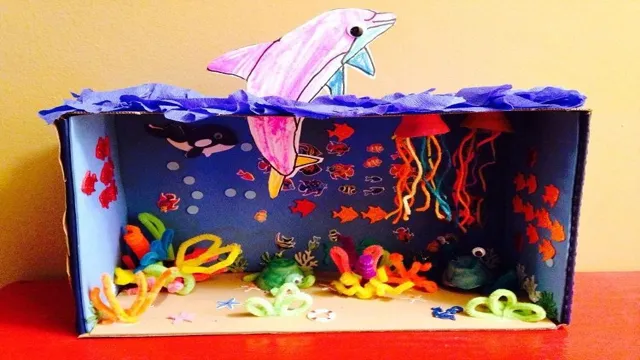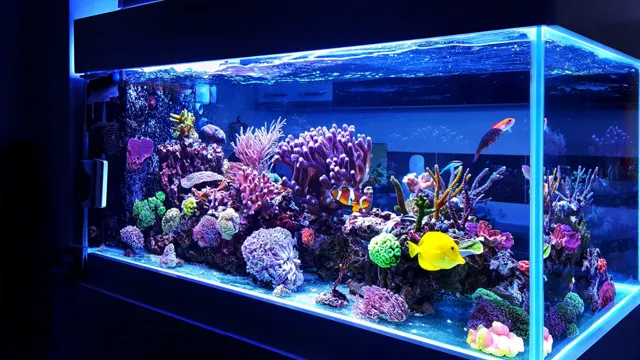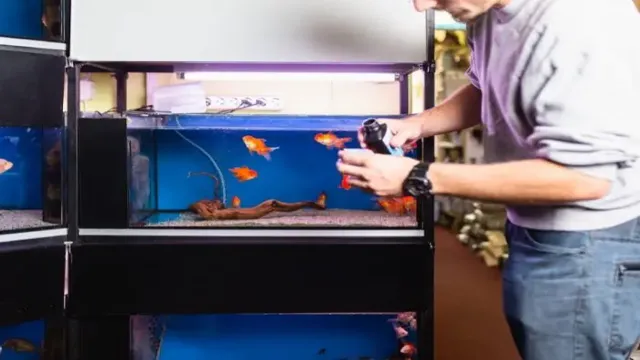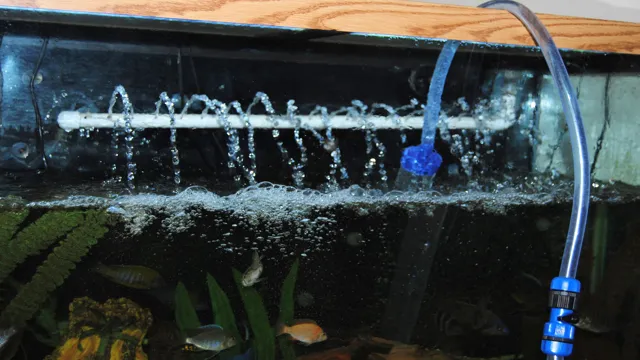Do you remember the excitement of creating your first school project? It’s that time of the year when students rack their brains to come up with engaging project ideas that will impress their teachers. If you’re looking for a unique and exciting school project, then why not consider making an aquarium? Not only will it be fun to build, but it’ll also teach you about aquatic life, biology, and science. In this blog, we will take you through everything you need to know about making an aquarium for a school project.
From selecting the right fish to choosing the perfect tank, we’ve got you covered. So let’s dive in!
Materials You Will Need
If you’re looking to create an aquarium for a school project, there are several materials you’ll need to get started. First and foremost, you’ll need a container to serve as the aquarium itself. This could be anything from a simple glass or plastic bowl to a more elaborate fish tank with a built-in filter.
You’ll also need water, of course, as well as gravel or sand to line the bottom of the aquarium. Other essential materials include plants (either live or fake), decorations like rocks or shells, and a heater if you plan to keep tropical fish. Depending on the type of fish you choose, you may also need an air pump to help regulate oxygen levels in the water.
Overall, making an aquarium can be a fun and educational activity for both students and teachers alike, and with the right materials and care, it can provide a beautiful and thriving habitat for your aquatic pets.
Glass container, gravel, decorative rocks, plastic plants, filter, air pump, fish food
If you’re ready to start your own little aquatic ecosystem, there are a few materials that you’ll need to gather first. First, you’ll need a glass container to house your fish and plants. It’s essential that you choose a container that is large enough for your fish to swim around comfortably.
You’ll also want to grab a bag of gravel and some decorative rocks to create the base of your underwater garden. Plastic plants can be used to add some greenery and create a more natural environment for your fish. A filter and air pump are critical to maintain the water quality by ensuring proper circulation.
Finally, don’t forget to grab some fish food so that your finned friends can thrive and grow. Make sure you choose high-quality fish food with the right nutrient balance for your specific species. With all of these materials, your aquatic wonderland will be up and running in no time!

Setting Up Your Aquarium
If you need to make an aquarium for a school project, setting it up can be a fun and rewarding task. First, choose the right size tank for your project and consider the type of fish you would like to keep. A 10-gallon tank is a good size to start with, and it can comfortably house several small fish.
Once you have your tank, fill it with clean, fresh water and add a suitable filtration system to keep your fish healthy. You may also want to add aquarium decorations to create a more engaging environment for your fish. Next, add plants and rocks to the bottom of the tank to mimic the natural environment of your fish.
Finally, choose the right type of fish food and start feeding your fish on a regular schedule. With a little bit of effort and attention, you can create a beautiful and educational aquarium that will impress your classmates and teachers alike. So why not give it a try and see what kind of underwater world you can create?
Rinse the gravel and decorative rocks, add them to the container. Place the plastic plants where desired. Install the filter and air pump according to instructions
If you’re just starting out with aquariums, setting up your own can seem like a daunting task. Don’t worry, it’s easier than it looks! Once you’ve chosen the right size tank for your space and selected the appropriate gravel and decorative rocks, it’s time to rinse them out. Rinsing the gravel removes any dust or debris that may be lingering in there. (See Also: How to Prepare Dry Rock for Aquarium: Simple Steps for a Healthy Tank)
Once that’s done, add the gravel to the tank and arrange the decorative rocks as you please. Now, when it comes to the plastic plants, it’s entirely up to you how you want to arrange them. Remember to read the instructions carefully when it comes to installing the filter and air pump.
Following these instructions to the letter can be the difference between a healthy tank and a disaster waiting to happen. Once these steps have been completed, you’re all set! Your aquarium will be ready for your fishy friends to call home.
Choosing Fish for Your Aquarium
If you’re looking to make an aquarium for a school project, choosing the right fish is key. First, consider the size of your tank and how many fish it can comfortably accommodate. Always avoid overcrowding, as this can cause stress and illness for your fish.
Secondly, think about the water temperature in the tank. Different fish species thrive at different temperatures, so make sure to choose fish that are well-suited to the range your tank provides. Finally, think about the level of care and attention your fish will require.
Some species are hardier and more low-maintenance, while others need specialized care and attention. Ultimately, the type of fish you choose for your aquarium can have a big impact on the success of your project, so take the time to research and choose carefully. With the right choices, you can create a beautiful, thriving underwater ecosystem as the focal point of your project.
Consider the size of the container and the type of fish. Avoid overcrowding. Choose fish that are easy to care for
When it comes to selecting fish for your aquarium, there are a few things to consider. First, you need to think about the size of your tank. Overcrowding your fish can lead to poor water quality and stressed fish.
A general rule of thumb is to have one inch of fish per gallon of water in your tank. Next, consider the type of fish you want to keep. Some fish require more care than others, so it’s important to choose fish that are easy to care for if you’re new to aquariums.
Some popular options for beginners include guppies, tetras, and bettas. Remember to research each species to see if they’re compatible with one another, as some fish can be territorial. By carefully considering the size of your aquarium and the type of fish you want to keep, you can create a beautiful and healthy environment for your aquatic friends to thrive in.
Caring for Your Aquarium
If you’re considering creating an aquarium for a school project, it’s important to know that it requires proper care and maintenance. First and foremost, you need to choose the right size aquarium for your fish and their environment. You may also want to consider adding decorations or live plants to your aquarium to enhance its natural appearance and provide a more stable environment for your fish to thrive in.
It’s crucial to test and regulate the water pH, temperature, and other chemical levels in your aquarium regularly to ensure that your fish remain healthy and happy. Additionally, you’ll need to feed your fish with quality food and clean the aquarium regularly to ensure that there isn’t any buildup of harmful bacteria or waste. Creating an aquarium can be a fun and educational activity for your school project, as long as you are willing to commit to proper care and maintenance.
Change the water regularly, feed the fish according to their needs. Monitor the temperature and pH levels. Clean the filter and container regularly
Taking care of your aquarium can be both fulfilling and challenging. To ensure the health and well-being of your aquatic pets, there are a few important steps you need to take. First, it’s essential to regularly change the water in your aquarium. (See Also: How to Make an Aquarium out of a Light Bulb: Step-by-Step Guide for Beginners)
This prevents the accumulation of harmful toxins and bacteria that can affect your fish’s health. Secondly, it’s crucial to provide your fish with the right kind of feed and in the right amounts. Overfeeding can cause digestive problems and pollute the water.
Monitoring the temperature and pH levels of your aquarium is also crucial, as water that’s too hot or too cold can adversely impact your fish’s health. Keeping your aquarium filter clean is also vital, as it helps to remove debris and waste, keeping the water clean and clear. Finally, clean the container regularly to prevent the buildup of algae, which can also be harmful to your fish.
By taking these simple steps, you can keep your aquarium healthy, your fish thriving, and enjoy the beauty of an underwater world. Remember, the well-being of your fish should always be your top priority.
Tips for a Successful Presentation
If you’re tasked with creating an aquarium for a school project, there are a few things to keep in mind to ensure its success. First, research the species of fish and plants you plan to include in your aquarium to ensure they can coexist and thrive together. You’ll also want to consider the size of your aquarium and the equipment needed to keep it clean and healthy.
When it comes to designing and building your aquarium, be creative and think outside the box. Incorporate decorations and accessories that add visual interest and replicate a natural underwater environment. Lastly, make sure you present your aquarium in a clear and concise manner, highlighting its unique features and explaining the thought process and effort put into its creation.
By following these tips, you’ll have a successful aquarium that showcases your creativity and knowledge.
Prepare a clear introduction and conclusion. Provide interesting facts about the fish and their habitat. Show before and after pictures of the aquarium. Allow the audience to ask questions.
Planning a presentation on fish and their habitat in an aquarium can be intimidating, but with the right tips, it can be a success. The first step is to prepare a clear introduction that grabs the audience’s attention and explains the purpose of the presentation. Including interesting facts and stories about the fish and their life in the tank can make the presentation more engaging and informative.
Before and after pictures of the aquarium can also create a powerful visual impact and can help the audience understand the transformation. Concluding the presentation with a summary and a call to action can reinforce the main message and encourage the audience to take action. Finally, allowing the audience to ask questions can help clarify any doubts and create a dialogue between presenter and attendees.
Overall, with these tips, anyone can create a compelling presentation on fish and their habitat, leaving the audience engaged and informed.
Conclusion
In conclusion, creating an aquarium for a school project is not only a fun and exciting activity, but it also provides an excellent educational opportunity for students of all ages. From researching the types of fish and aquatic plants to understanding how to maintain water quality, building an aquarium requires critical thinking and problem-solving skills. Plus, it’s a great way to bring a little piece of nature into the classroom and encourage an appreciation for our underwater ecosystems. (See Also: How Thick is Aquarium Acrylic Need to be for Safe and Secure Tank? – Expert Guide)
So, go ahead and dive in – with a bit of creativity and a lot of patience, you’ll have a fin-tastic aquarium in no time!”
FAQs
What materials do I need to make an aquarium for a school project?
You will need a glass or plastic container, water, gravel or sand for the bottom, plants, rocks or decorations, and a filter or air pump.
How big should my aquarium be for a school project?
The size of your aquarium can vary depending on the requirements of your school project. A common size for small projects is around 10 to 20 gallons.
Can I use real fish in my school project aquarium?
It is not recommended to use real fish in your school project aquarium as they require proper care and maintenance. Plastic or toy fish can be used as an alternative.
Do I need to cycle the water in my school project aquarium?
It is recommended to cycle the water in your aquarium for at least a week before adding any plants or decorations, to ensure that the water is balanced.
What types of plants can I use in my school project aquarium?
You can use a variety of freshwater plants such as Anubias, Java fern, or Amazon swords. Make sure to research the specific requirements for each type of plant.
How do I clean my school project aquarium?
Regular maintenance such as water changes and cleaning the filter or air pump is important to keep your aquarium clean. Use a gravel vacuum to remove any debris from the bottom of the tank.
Can I add other aquatic animals to my school project aquarium besides fish?
Depending on the size of your aquarium, you may be able to add other aquatic animals such as snails, shrimp, or frogs. However, research their compatibility and specific care requirements before adding them to your aquarium.







